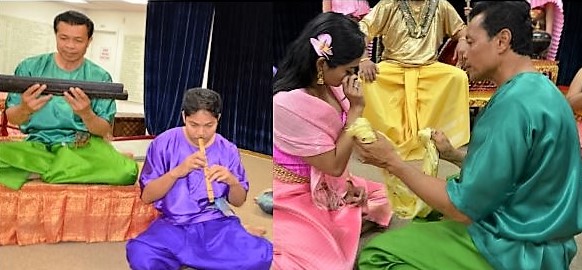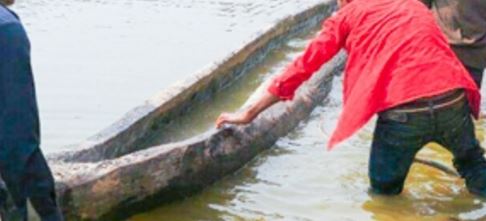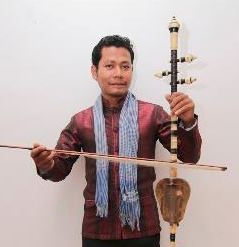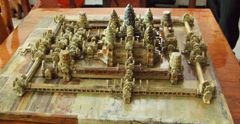Bonn Chrot Preah Nangkol
Cambodians are predominantly farmers, so this ritual is very popular as it is an agrarian festival in Cambodia. The ceremony is held in the third week of May, the beginning of rainy season when farmers get ready for the rice planting season.
The Royal Ploughing Ceremony is done according to Satra, a book of traditions, that Cambodian should consult before taking any action. It is solemnly celebrated at the beginning of the sowing and planting season to signify a deep connection with the earth and the farming. There is a deep astrological belief that the Royal Ox has an instrumental role in determining the fate of the agricultural harvest each year. The ceremony is also an occasion held to pray gods for good harvest.
The ceremony is rooted in Brahman's believe of a five-days feast. On the 1st day of the waning moon, the Brahmans conduct feasting at the five decorated canopies positioned at five compass points: East, Southeast, Southwest, Northwest, and Northeast. After the five days of the Brahman feast, the King initiates the ploughing to ensure success in farming for all his people.
The King assumes a role of Sdach Miech and the Queen assumes a role of Preah Mehour. If the King and Queen are not able to attend, a representative and his wife assume roles of Sdach Miech and Preah Mehour to do the duty. Sdech Miech sits on Preah Salieng and Preah Mehour sits on a hammock like litter.
In the ceremony, the King ploughs a field and the Queen sows seeds behind as pinpeat music is playing. Citizens are watching so anxiously to learn the outcome of the astrological harvest prediction.
Before plowing, Sdech Miech and Preah Mehour pay their respects at the decorated canopy located to the Southwest. The ceremony is based around three ploughs: the leading plough is called Nangkol Yong, the second one is ploughed by the king. Preah Mehour walks following the third plough, sowing the rice seeds carried by one of her aids. Pin Peat continues playing Bot Klom until the procession has been around the Royal rice-fields three times.
The ploughing stops at the decorated canopy located in the East and the king pays his respects again and then returns to his seat.
After plowing, a royal servant drives a two Royal Ox to holy trays that contains rice, corn, bean, sesame, grass, water and wine. The oxen are expected to consume those foods and beverages. At the same time, the royal soothsayers or a group of Brahmans make predictions using the holy cows. These predictions are based on what the holy cows eat.
If the oxen:
- drink water, it means there will be enough rain for rice planting;
- eat rice, it means a good harvest for farmers in the year ahead;
- eat soybeans, it means a bountiful harvest of soybeans;
- eat sesame, it means a bountiful harvest of sesame;
- eat corn, it means a bountiful harvest of corn;
- eat grass, it means disease will prevail over the nation;
- drink wine, it means the nation will suffer at the hands of gangsters, robbers, or drunkards.

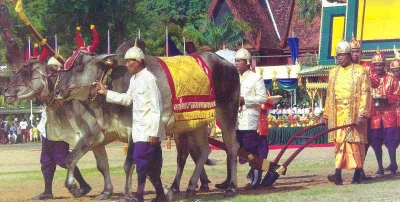
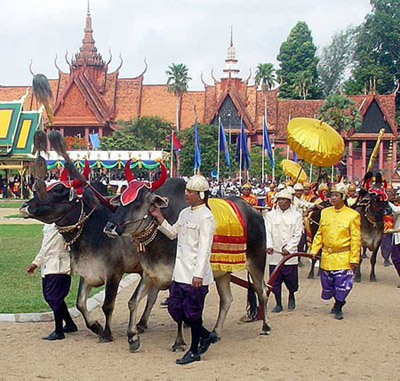
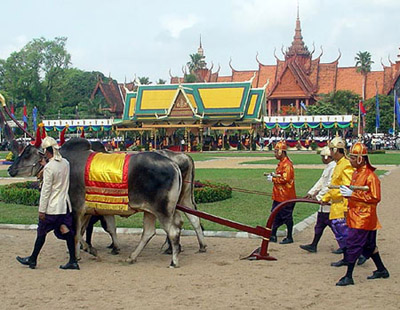
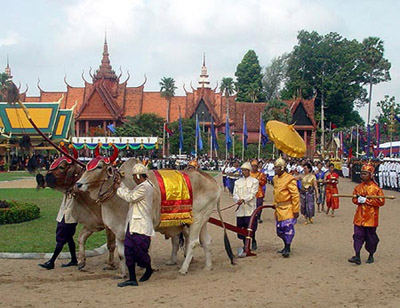
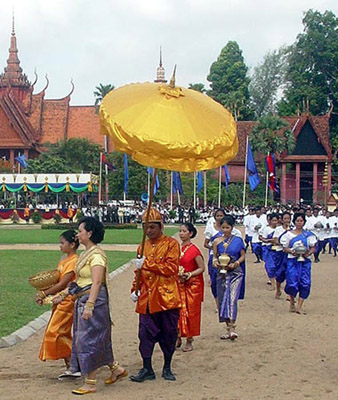
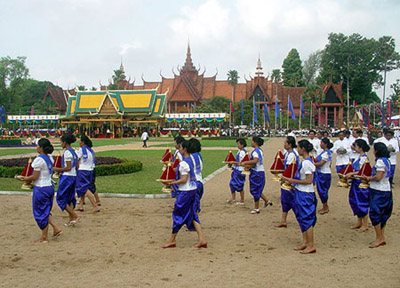
Sources:
- http://www.asiarooms.com/en/travel-guide/cambodia/phnom-penh/sightseeing-in-phnom-penh/bonn-chroat-preah-nongkoal-in-phnom-penh.html
- http://www.embassyofcambodia.org.nz/ploughingceremony.htm
- Photo courtesy of http://www.frizz-restaurant.com/



















































 Welcome to the Cambodian Cultural Festival of 2018. It is free and open to all. This year, we bring you another type of entertainment: a Yeekae entitled “Kolab Pailin”. Yeekae is a Cambodian musical show that tells a story through a traditional music and dance. It also faces extinction. The story is a Cambodian literature written by Mr. Nhok Them. It contains lots of cultural and educational values. Never before the story is used in a form of Yeekae (yike) art. We are the first one.
Welcome to the Cambodian Cultural Festival of 2018. It is free and open to all. This year, we bring you another type of entertainment: a Yeekae entitled “Kolab Pailin”. Yeekae is a Cambodian musical show that tells a story through a traditional music and dance. It also faces extinction. The story is a Cambodian literature written by Mr. Nhok Them. It contains lots of cultural and educational values. Never before the story is used in a form of Yeekae (yike) art. We are the first one.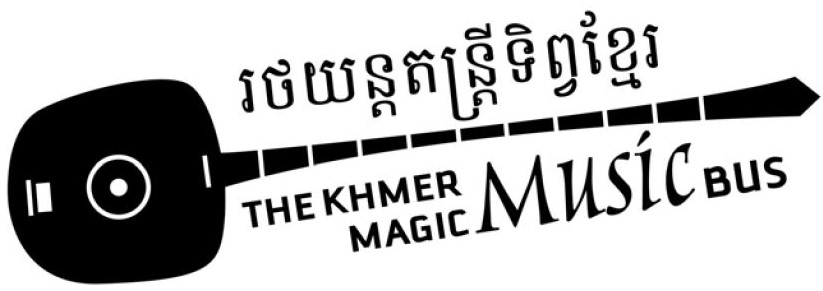 A group of Cambodian musicians, the Khmer Magic Music Bus, will be visiting USA from October 24 to November 13, 2018. It is part of "arts4peace" tour organized by Cambodian Living Arts. CCD will host a meet-n-greet event at Cambodian Buddhist Temple of Silver Spring, 13800 New Hampshore Ave, Silver Spring MD 20904 Sunday November 11, 2018 2-5 PM. Contact Kunthary DeGaiffier 202-413-6461.
A group of Cambodian musicians, the Khmer Magic Music Bus, will be visiting USA from October 24 to November 13, 2018. It is part of "arts4peace" tour organized by Cambodian Living Arts. CCD will host a meet-n-greet event at Cambodian Buddhist Temple of Silver Spring, 13800 New Hampshore Ave, Silver Spring MD 20904 Sunday November 11, 2018 2-5 PM. Contact Kunthary DeGaiffier 202-413-6461.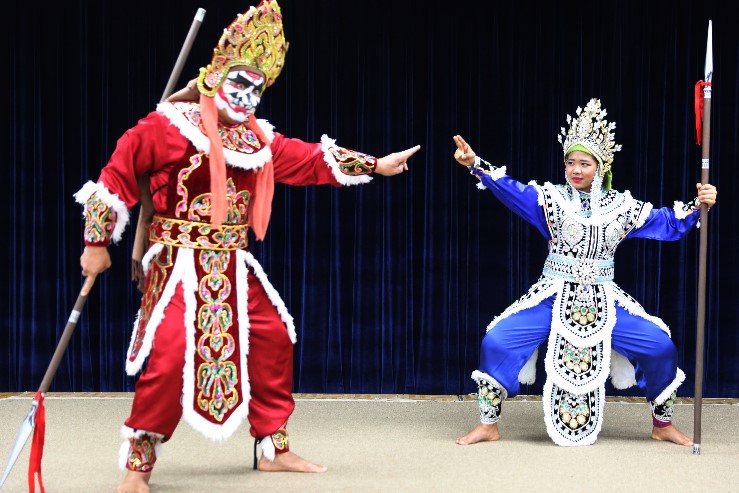 Welcome to the Cambodian Cultural Festival of 2017. It is free and open to all. Whether you have an earnest desire to learn more about the rich Cambodian culture, the oldest in Southeast Asia, or simply are looking to have fun for one Sunday, this is an event you do not want to miss. This year, among many other dances, we have a pleasure to bring you a Cambodian traditional dance opera entitled Lakhon Bassac "Tip Sangva". This type of Cambodian entertainment was once popular in Cambodia in the old days, but now, according to UNESCO, it is almost extinct. Our mission is to promote, present and preserve Cambodian culture. This year we have a great opportunity to do just that to revitalize this traditional entertainment.
Welcome to the Cambodian Cultural Festival of 2017. It is free and open to all. Whether you have an earnest desire to learn more about the rich Cambodian culture, the oldest in Southeast Asia, or simply are looking to have fun for one Sunday, this is an event you do not want to miss. This year, among many other dances, we have a pleasure to bring you a Cambodian traditional dance opera entitled Lakhon Bassac "Tip Sangva". This type of Cambodian entertainment was once popular in Cambodia in the old days, but now, according to UNESCO, it is almost extinct. Our mission is to promote, present and preserve Cambodian culture. This year we have a great opportunity to do just that to revitalize this traditional entertainment. 